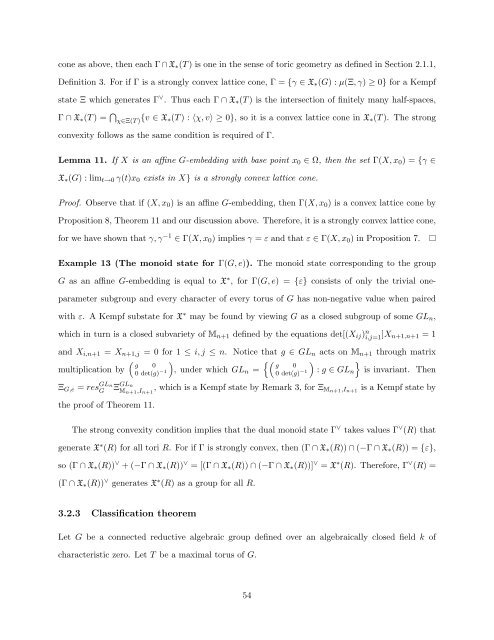Equivariant Embeddings of Algebraic Groups
Equivariant Embeddings of Algebraic Groups
Equivariant Embeddings of Algebraic Groups
You also want an ePaper? Increase the reach of your titles
YUMPU automatically turns print PDFs into web optimized ePapers that Google loves.
cone as above, then each Γ ∩ X ∗ (T ) is one in the sense <strong>of</strong> toric geometry as defined in Section 2.1.1,<br />
Definition 3. For if Γ is a strongly convex lattice cone, Γ = {γ ∈ X ∗ (G) : µ(Ξ, γ) ≥ 0} for a Kempf<br />
state Ξ which generates Γ ∨ . Thus each Γ ∩ X ∗ (T ) is the intersection <strong>of</strong> finitely many half-spaces,<br />
Γ ∩ X ∗ (T ) = ⋂ χ∈Ξ(T ) {v ∈ X ∗(T ) : 〈χ, v〉 ≥ 0}, so it is a convex lattice cone in X ∗ (T ). The strong<br />
convexity follows as the same condition is required <strong>of</strong> Γ.<br />
Lemma 11. If X is an affine G-embedding with base point x 0 ∈ Ω, then the set Γ(X, x 0 ) = {γ ∈<br />
X ∗ (G) : lim t→0 γ(t)x 0 exists in X} is a strongly convex lattice cone.<br />
Pro<strong>of</strong>. Observe that if (X, x 0 ) is an affine G-embedding, then Γ(X, x 0 ) is a convex lattice cone by<br />
Proposition 8, Theorem 11 and our discussion above. Therefore, it is a strongly convex lattice cone,<br />
for we have shown that γ, γ −1 ∈ Γ(X, x 0 ) implies γ = ε and that ε ∈ Γ(X, x 0 ) in Proposition 7.<br />
Example 13 (The monoid state for Γ(G, e)). The monoid state corresponding to the group<br />
G as an affine G-embedding is equal to X ∗ , for Γ(G, e) = {ε} consists <strong>of</strong> only the trivial oneparameter<br />
subgroup and every character <strong>of</strong> every torus <strong>of</strong> G has non-negative value when paired<br />
with ε. A Kempf substate for X ∗ may be found by viewing G as a closed subgroup <strong>of</strong> some GL n ,<br />
which in turn is a closed subvariety <strong>of</strong> M n+1 defined by the equations det[(X ij ) n i,j=1 ]X n+1,n+1 = 1<br />
and X i,n+1 = X n+1,j = 0 for 1 ≤ i, j ≤ n. Notice that g ∈ GL n acts on M n+1 through matrix<br />
( {( ) }<br />
g 0<br />
g 0<br />
multiplication by<br />
0 det(g)<br />
), −1 under which GL n =<br />
0 det(g) −1 : g ∈ GL n is invariant. Then<br />
Ξ G,e = res GLn<br />
G<br />
ΞGLn M n+1 ,I n+1<br />
, which is a Kempf state by Remark 3, for Ξ Mn+1 ,I n+1<br />
is a Kempf state by<br />
the pro<strong>of</strong> <strong>of</strong> Theorem 11.<br />
The strong convexity condition implies that the dual monoid state Γ ∨ takes values Γ ∨ (R) that<br />
generate X ∗ (R) for all tori R. For if Γ is strongly convex, then (Γ ∩ X ∗ (R)) ∩ (−Γ ∩ X ∗ (R)) = {ε},<br />
so (Γ ∩ X ∗ (R)) ∨ + (−Γ ∩ X ∗ (R)) ∨ = [(Γ ∩ X ∗ (R)) ∩ (−Γ ∩ X ∗ (R))] ∨ = X ∗ (R). Therefore, Γ ∨ (R) =<br />
(Γ ∩ X ∗ (R)) ∨ generates X ∗ (R) as a group for all R.<br />
3.2.3 Classification theorem<br />
Let G be a connected reductive algebraic group defined over an algebraically closed field k <strong>of</strong><br />
characteristic zero. Let T be a maximal torus <strong>of</strong> G.<br />
54
















